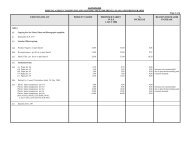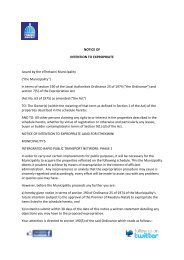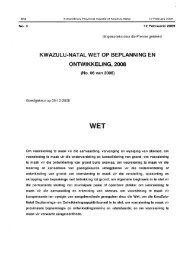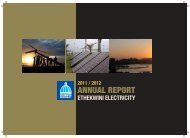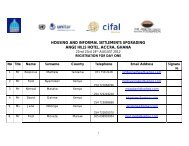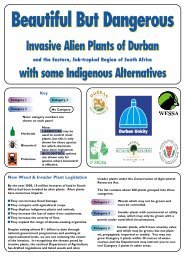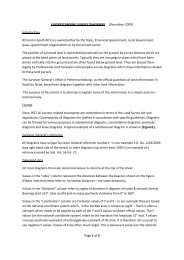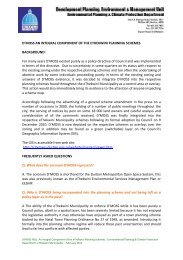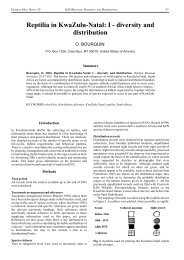Mullin, S. K., Taylor, P. J. & Pillay, N. 2004. Skull size and ... - Durban
Mullin, S. K., Taylor, P. J. & Pillay, N. 2004. Skull size and ... - Durban
Mullin, S. K., Taylor, P. J. & Pillay, N. 2004. Skull size and ... - Durban
You also want an ePaper? Increase the reach of your titles
YUMPU automatically turns print PDFs into web optimized ePapers that Google loves.
MULLIN_08 13/08/04 12:45 Page 4<br />
<strong>Mullin</strong> S. K. et al.<br />
separate Dasymys species was recorded (e.g. Chitau,<br />
Angola; Musser & Carleton 1993; Luluabourg,<br />
Zaire; Crawford-Cabral 1986). Finally, after<br />
consulting vegetation, geology, soil, altitude <strong>and</strong><br />
phytogeographic maps, the localities that were<br />
represented by less than three individuals were<br />
pooled into Operational Taxonomic Units (OTUs),<br />
while respecting geographical barriers such as<br />
mountain ranges <strong>and</strong> rivers, which represented<br />
geographically close localities found in the same<br />
biome type (after <strong>Taylor</strong> & Meester 1993; Table 1).<br />
If a locality consisted of less than 3 individuals<br />
<strong>and</strong> it was not possible to combine that locality<br />
into an OTU, the data were treated separately. In<br />
this case, the canonical scores of individuals were<br />
projected onto the scores of the OTUs to produce<br />
a comprehensive plot. Symbols were assigned to<br />
species, subspecies or areas of interest in the diagrams<br />
presented in the results section.<br />
TRADITIONAL MORPHOMETRICS<br />
Multivariate methods were employed on a dataset of<br />
804 individuals. The character suite consisted of the<br />
following 13 cranial characters (see <strong>Mullin</strong> et al.<br />
2002): GSL-Greatest skull length; UTR-Crown<br />
length of upper (maxillary) toothrow; PWM-Hard<br />
palate width; NAS-Nasal width; ZYN-Zygomatic<br />
arch width; FRO-Greatest internal diameter of zygomatic<br />
arch; IOB-Least breadth of interorbital<br />
constriction; FMW-Foramen magnum width;<br />
UMW-Least width of zygomatic arch; ZPW-<br />
Zygomatic plate width; GML-Greatest m<strong>and</strong>ible<br />
P R O O F<br />
length; MTR-M<strong>and</strong>ibular tooth row; GHS-Greatest<br />
height of skull. The dataset was normally distributed,<br />
non-kurtotic, non-skewed <strong>and</strong> homoscedastic.<br />
Only two of the localities examined in this study<br />
(Limalunga, Zambia <strong>and</strong> Okavango-Omatako,<br />
Namibia) had a large number of unbroken skulls<br />
that could be used to examine non-geographic<br />
variation. A previous study of non-geographic<br />
variation (based on individuals from Limalunga,<br />
Zambia only) revealed that specimens from ageclasses<br />
III, IV, V, VI represent adult D. incomtus<br />
individuals (<strong>Mullin</strong> et al. 2001) <strong>and</strong> that sexual<br />
dimorphism is negligible in D. incomtus populations<br />
(<strong>Mullin</strong> et al. 2001). The same analysis was<br />
completed on individuals from Okavango-Omatako,<br />
4<br />
Namibia <strong>and</strong> produced the same results. In addition,<br />
Carleton & Martinez showed that neither D. foxi<br />
nor D. rufulus exhibited sexual dimorphism <strong>and</strong><br />
therefore the data for adult males <strong>and</strong> females<br />
were pooled in the analyses presented in this study.<br />
St<strong>and</strong>ardised data were subjected to multivariate<br />
analyses, including a principal component analysis<br />
(PCA), a multi-group canonical variates analysis<br />
(CVA), which tested multivariate differences<br />
among OTUs <strong>and</strong> an unweighted pair-group<br />
means with averages (UPGMA) cluster analysis (CA)<br />
based on Euclidean distances. A CA was also used<br />
to produce a phenogram of the distinct morphological<br />
groups discerned in this study. The PCA <strong>and</strong><br />
CVA plots <strong>and</strong> CA phenograms for each subgroup<br />
were all used to obviate bias possibly resulting from<br />
the use of only one approach. Since the different<br />
approaches provided similar results, we subjectively<br />
chose scatterplots <strong>and</strong> phenograms for the results<br />
section for ease of presentation. Although CA is<br />
considered an exploratory method, we included<br />
the phenograms since strong patterns were seen.<br />
An Analysis of Variance (ANOVA) was completed<br />
on morphologically distinct groups (see results<br />
section) to determine significant differences in both<br />
cranial <strong>and</strong> external measurements. A Student<br />
Newman-Keuls (SNK) multiple range test was<br />
used to examine inter-group variation. These tests<br />
included the following additional characters to the<br />
ones mentioned above: BBC-braincase breadth,<br />
HB-head-body length (mm), TL-tail length (mm),<br />
HF-hind foot length (mm), E-ear length (mm),<br />
TOT-total body length (mm), M-Mass (g) <strong>and</strong><br />
HB/TL-head-body/tail ratio (mm). These characters<br />
were not included in multivariate methods as<br />
one (BBC) was highly correlated with other characters<br />
used <strong>and</strong> others (HB, TL, HF, E, TOT, M <strong>and</strong><br />
HB/TL) had a large number of missing values.<br />
All of the statistical analyses were undertaken<br />
using the program NTSYS-pc (Rohlf 1996), except<br />
for the ANOVA <strong>and</strong> Student Newman-Keuls<br />
multiple range test which were done using Statistica<br />
(StatSoft 2001).<br />
GEOMETRIC MORPHOMETRICS<br />
A 5mm Leica DC100 camera attached directly to<br />
a PC was used to capture images of the dorsal <strong>and</strong><br />
MAMMALIA • 2004 • 68 (2)


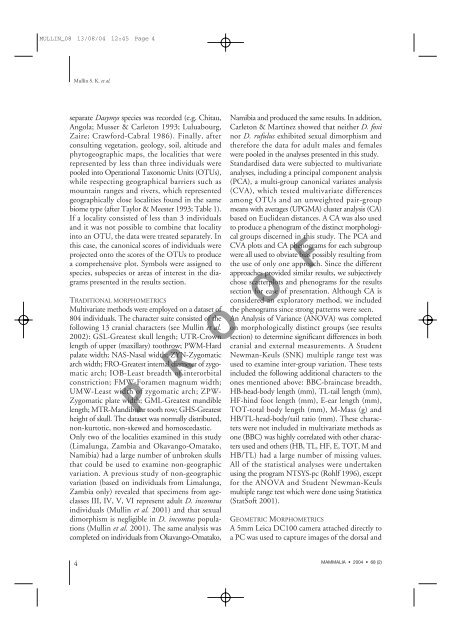
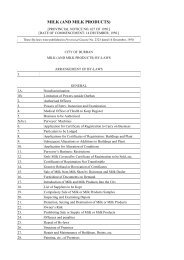
![INK Environmental Sustainability Booklet [19 MB] - Durban](https://img.yumpu.com/22025104/1/190x136/ink-environmental-sustainability-booklet-19-mb-durban.jpg?quality=85)

